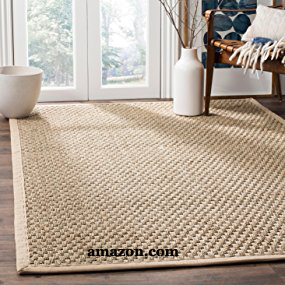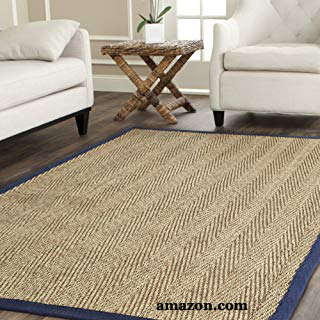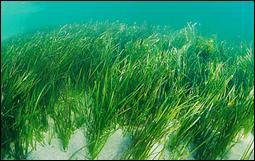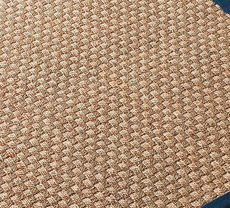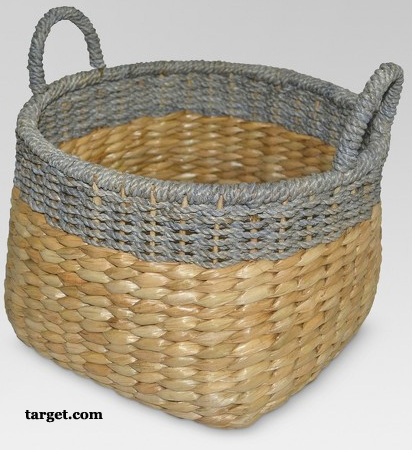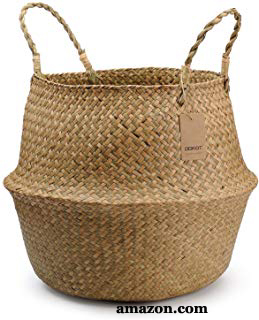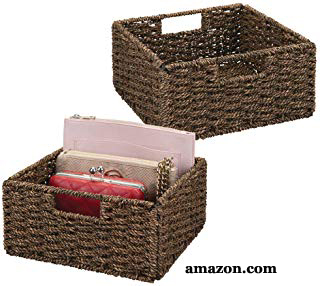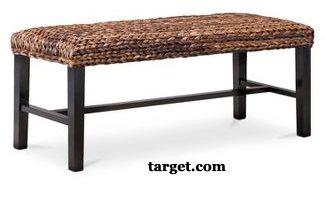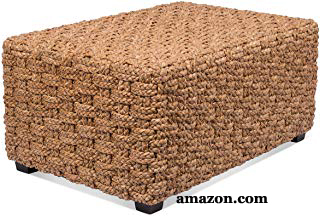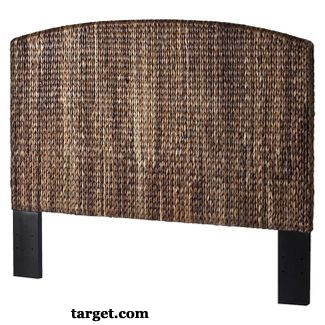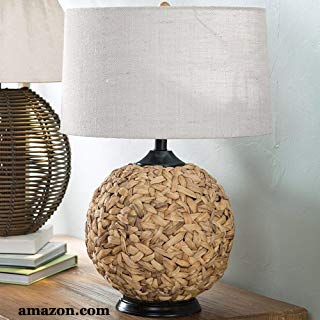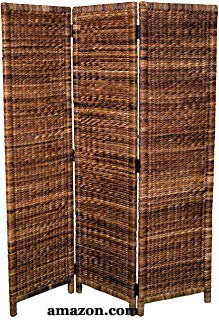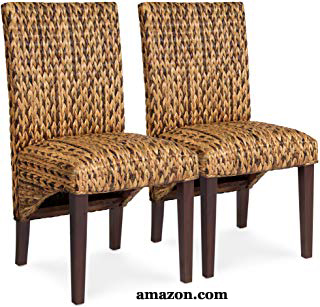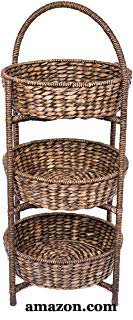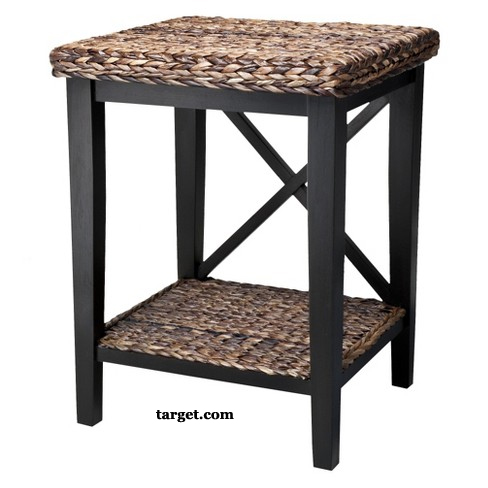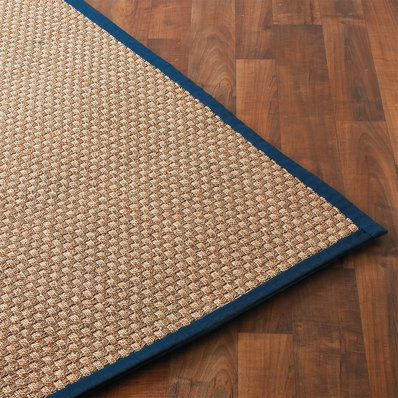SEAGRASS NATURAL FIBER
Seagrass natural fiber is another of the eco-friendly natural fibers used to make rugs, clothing, furniture, and more. Products made from seagrass natural fiber and other natural fibers such as abaca, bamboo, coir, hemp, jute, and sisal (as well as cotton and wool), each with their earthy texture, warmth, and natural beauty, can harmonize successfully with all different color schemes and can bring a sense of calm and relaxation to a living area.
Rug and carpet products made from natural fibers come from sustainable and renewable resources, which gives them a big advantage over synthetic plastic fibers with manufactured colors.
Natural fibers (other than wool) are best suited for area rugs, since they are either too weak or too rough to be made into wall-to-wall carpeting.
Please note: Natural fiber rugs do not release toxic VOC gases as do synthetic fiber rugs, but beware of natural fibers attached to a synthetic backing, since VOC gases can then occur.
Natural fibers, in general, are more expensive than their synthetic counterparts. They also need specialty cleaning products as well as professional cleaning techniques, making them possibly more costly to maintain.
THE SEAGRASS PLANT
Seagrasses are a collective group of flowering plants that are biologically grasses. They are ancient plants that evolved nearly 100 million years ago! They are very fast-growing and a single acre of seagrass can produce more than 10 tons a year.
Seagrass is a reedy plant grown very much like rice and it gets its name from the fact it is planted in paddy fields that are flooded with seawater during each growing season. (Thus, the name 'seagrass.') It is typically grown in marshy areas but it is called Dragon Grass when it is grown in more arid soil where it will take on a darker color.
These grasses, sometimes also called water hyacinth, live underwater and grow best in the ocean or in any other salinated, standing bodies of water. There are approximately 60 species of seagrass that habitate marine environments around the world. They grow in what is known as 'seagrass meadows' that are literally 'prairies of the seas.'
Seagrasses produce oxygen for their biologically diverse environment. Oceans are able to absorb 25% of total global carbon emissions and the seagrass meadows account for 15% of that total.
Besides a wide array of products, such as rugs, baskets, furniture, etc., seagrasses provide wave and coastal erosion protection as well as fishing grounds.
SEAGRASS vs. SEAWEED
Seagrass can easily be confused with marine macroalgae, or seaweed, but there are many important differences between the two. They differ in reproduction, structure, and how they transport nutrients and dissolved gases.
Another important difference is seagrasses are vascular plants and have roots, stems, and leaves, while seaweed are multi-cellular algae and have little or no vascular tissue at all.
SEAGRASS AREA RUGS
Seagrass natural fiber produces a strong, non-porous yarn for seagrass area rugs that is resistant to spots and stains.
Depending on the relative humidity in their surrounding environment, natural fiber rugs such as those made from seagrass can repel water but saturation of the fibers with water can cause dimensional change or shrinkage and the possibility of damage due to mold and mildew.
Immediate action to blot up any accidental spills and dry the area as quickly and as thoroughly as possible is necessary. Once a water spill on a seagrass natural fiber rug dries, the rug should return to its normal color.
PROS of SEAGRASS NATURAL FIBER RUGS
- Seagrass natural fiber rugs are very tough and almost impermeable. This toughness makes them less vulnerable to abrasion when compared to conventional floor coverings.
- The texture of the rugs when woven is softer to walk on than other tough natural fibers such as sisal (though not as soft as hemp.) A rug underlayment or pad can help to further soften the feel underfoot.
- The dense weave of Seagrass natural fiber rugs makes them super strong and very durable. They can be used in high-traffic areas such as entryways, hallways, living rooms or game rooms. (But not in rooms with moisture.) The strength and durability of seagrass fibers makes them a natural to be used in wicker furniture.
- The fibers are non-porous and water repellent since the plant is grown in water. This can make pet accidents easier to clean up. However, as mentioned above, these rugs can be susceptible to mold and mildew damage from too much moisture.
- The fibers are stain-resistant because they are non-porous and because of their natural waxy coating. Dirt doesn't cling to the fibers and so they are less likely to stain. The thick fibers show minimal watermarks and stains. Stain protector coatings can be applied, if desired.
- Seagrass is good for the environment (eco-friendly) because it is fast growing and easy to harvest. It is also biodegradable.
- Seagrass natural fiber area rugs can provide noise insulation, an added benefit in high traffic areas.
- The fibers have anti-static properties.
- The fibers have mild anti-bacterial properties and do not collect allergens.
- The natural lines in a seagrass natural fiber rug are in a row. Thus, if a seagrass rug needs to be seamed, the resulting seams will not be visible.
CONS OF SEAGRASS NATURAL FIBER RUGS
- Because the fibers are almost impermeable, the fibers of seagrass natural fiber rugs do not take dyes well so color choices are limited. Small variations in colors can be due to what species of seagrass the farmer has planted. (Sometimes, colored weft strings (side-to side threads) are woven through the fibers to create interesting and contrasting effects.)
- Susceptible to damage from moisture and can be subject to the growth of mold and mildew in wet environments. Spills must be wiped up immediately. Not to be used in wet kitchens or bathrooms.
- The fibers are very smooth and could possibly be slippery. Thus, seagrass rugs would have to be installed on stairs with the grain facing parallel to the stair treads.
- The rugs can be subject to sprouting because of shorter fibers.
- A seagrass rug is typically bound with cotton or leather and often comes with a latex backing. Thus, it may not be reversible.
- Slight weaving and shade irregularities are common characteristics with seagrass rugs as well as with some other natural fibers such as sisal.
- Seagrass fibers are subject to fading when exposed to sunlight.
MAINTENANCE OF SEAGRASS NATURAL FIBER AREA RUGS
Vacuuming
- Daily care would include vacuuming with a regular vacuum (beater-type not as effective) to pull out any fine dirt which has accumulated between the fibers.
- Vacuum in different directions with multiple passes to pull up the loose dirt from the weave.
- Make sure to vacuum the bindings in the direction of the stitches to avoid pulling and to maintain the edging.
- For leather binding, wipe with a damp cloth or apply a leather cleaner following manufacturer's directions.
If Fibers Need Tightening:
- This procedure is for rugs in dry climates or areas of low humidity only!
- Vacuum rug before begining.
- Apply a light and even application of water as with a spray bottle or clean mop or damp brush.
- DO NOT Saturate.
- As the rug dries, the fibers will tighten up slightly.
Curling of Edges:
An area rug made of seagrass with edges subject to heavy traffic or shuffling of feet across a corner or edge could cause the edge to curl:
- Dampen the curled area or place a damp towel over the area.
- Weight the area down evenly and leave overnight.
- May need to be repeated if the curling is severe.
SEAGRASS NATURAL FIBER
AREA RUG
SPOT and SPILL REMOVAL
PROCEDURES
General Spot and Spill Removal Procedures
- Blot up spills immediately with clean, undyed white cloths or undyed paper towels.
- Remove any solids with a spoon or butter knife.
- Use a clean wet undyed white cloth to blot up any residue. (Club soda may be helpful to remove tomato or red wine.)
- Dry quickly as with a hair dryer. (Generally, seagrass will not leave a spot or watermark when it dries after blotting with a damp towel.)
Specific Spot and Spill Removal Information
For Beer, Blood, Butter, Chocolate, Coffee, Cola, Cream, General Dirt, Eggs, Excretion, Fruit, Greasy Food, Ice Cream, Juice, Lipstick, Liquor, Water-Based Paint, Vomit:
- Mop up the spill immediately with a clean undyed white cloth or undyed paper towels.
- Gently sponge or brush the discolored area with very small amounts of a neutral pH dish detergent such as Dawn and lukewarm water (cold water for blood). Do NOT saturate.
- Blot up with undyed white cloth or undyed paper towels.
- Repeat.
- Dry the rug quickly as with a hair dryer.
For Colored Chalk, Cosmetics, Fresh Oil, Oil-Based Paint, Shoe Polish, Soot, Tar:
- Carefully scrape up as much of the stain as possible, using a dull knife or nail file. (Soot should be vacuumed up first.)
- Dampen a clean, undyed white cloth with a small amount of dry cleaning fluid such as K2R (which can be found in most drug stores). May also try blotting with small amounts of turpentine.
- Work towards the center of the stain and use very little solvent to avoid spreading the stain.
- Repeat.
- Dry the carpet quickly as with a hair dryer.
For Nail Polish:
- Blot with small amounts of an acetone polish remover with a clean undyed white cloth.
For Greasy and Oily spots:
- K2R or aerosol can spot removers can be used following the directions on the container. These types of cleaners contain both a cleaning solvent and absorbing powder.
For Beer and Wine spills:
- Can use wood alcohol applied as above with a clean, undyed white cloth.
For Mud:
- Let the mud dry and then sweep it or vacuum it up.
For Urine:
- Blot with absorbent material.
- Mix 1/2 cup water and 1 tablespoon of ammonia. Stir the mixture as thoroughly as possible.
- Dab onto the stain, using an undyed white cloth or undyed paper towels.
- Cover the area with as little cleaner as possible to avoid damaging the rug.
- Follow with a clean, undyed white cloth or undyed paper towels dipped into clean water.
- Blot to pick up any ammonia left on the rug.
For Urine if smell still persists:
- Thoroughly mix 1/4 cup of vinegar with 1/4 cup of water. (Vinegar helps to remove the smell of urine so only use it when the scent lingers after normal spot cleaning.)
- Apply the solution to the rug with another dry, undyed white cloth or undyed paper towels.
- Pat the stained area with the cloth or paper towels.
- Dip a clean undyed white cloth or undyed paper towels in clean water. Wring out the excess and dab onto the treated area to remove the vinegar on the rug.
- Thoroughly dry all wet areas.
For Rust stains:
- Use a butter knife to scrape away any visible rust.
- Use a solution consisting of a neutral pH dish detergent such as Dawn and water to blot the stain.
- Let the solution sit for a few minutes and then blot up with a wet undyed cloth or undyed paper towels.
- If the stain is still present, repeat the process with 2 cups of warm water mixed with 1 tablespoon of ammonia.
To remove Mold or Mildew:
- In a bowl, add a cup of chlorine bleach and then dilute the bleach with 6 cups of water. Stir the mixture thoroughly to minimize the rug's exposure to the bleach.
- Pour the mixture into a spray bottle. The mixture cannot be applied directly on the rug. Mist a thin coating on the stained areas.
- Spray as lightly as possible, covering the rug in an even coating. Do NOT spray on the binding. Test the spray in a small area first to see if it discolors the rug. If it does, add more water to the mixture.
- Dry the rug. To ensure that none of the moisture or bleach soaks into the rug, dry the rug quickly using a hair dryer.
For Unknown stains:
If the stain is not known, experiment on a very small area with water and solvent in order to determine what will dissolve the substance.
IF ALL ELSE FAILS, PLEASE CALL OUR OFFICE AT 607-272-1566 TO SCHEDULE A PICKUP or BRING YOUR RUG TO OUR PLANT.
Seagrass rugs come in various natural shades of green, olive, and beige. Those natural colors will get a brownish tint as they age.
Area rugs made from these plants will emit a hay-like scent which will dissipate over time.
These area rugs can be expected to last from 5 to 15 years.
"The Cleanest Clean You've Ever Seen."
by
ABC Oriental Rug & Carpet Cleaning Co.
130 Cecil Malone Drive Ithaca, NY 14850
607-272-1566
